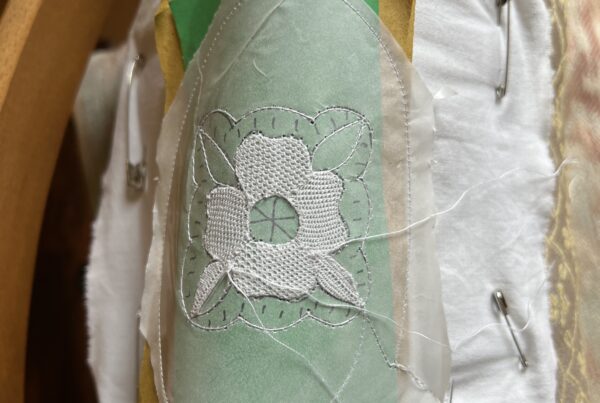Have you ever used a garment so much that it had rips and holes, but you loved it anyway?
Maybe you tried repairing it but didn’t work or maybe you threw it away crying because you couldn’t wear it anymore.
I’m here to tell you that you are not alone.
If you have any interest in sustainability or sewing (or both), you may have encountered a few bumps along the way, when it comes to repairing your clothes, especially when it comes to finding information on the topic.
There are infinite ways to repair and mend your clothes and the first step is always understanding the material we are dealing with. Depending on the material, we can use different techniques and tools for repairing our garments.
A classic example could be ripped jeans or a hole in a sweater. In both cases, you have to evaluate your sewing abilities, but denim is significantly easier to deal with than knitwear.
A great example of mending on denim and cotton in general, is a Japanese technique known as Sashiko. This kind of embroidery does not try to cover or erase the hole in the fabric but instead incorporates it inside the pattern.
You can try this technique even as a beginner and I’ll leave you a few resources at the end of the article to help you start every project I’ll talk about.
Another easy technique for beginners is the lazy daisy. I feel like this stitch is one of the most famous and you’ve probably seen it all over Pinterest. It’s a series of chain stitches all fixed on the same center, with a final stitch on top to create the center of the flower. This kind of stitch is great for covering small holes on knitwear or t-shirts, but be careful not to pull the thread too much or you’ll risk creating an even bigger hole.
My advice is to try and close the hole with a thin thread, possibly the same color as the fabric, and then stitch the daisy on top of it with a thicker thread.
If you want to cover a stain, you could try to find a nice patch to sew on top of it (the best ones are in vintage stores or flea markets), or, depending on the dimension and the color of the stain, you could try to make it part of the embroidery. Who says flaws are a bad thing?
If you have a jacket or a shirt that lost one or more buttons, do not despair! Haberdasheries are full of amazing buttons just waiting to be chosen by someone who has the right eye. I made quite a few button changes in my client’s jackets and rarely do they have only one type of button on the same garment. A lot of people love having fun with different kinds of materials and putting a small embroidery or one single different button in a very classic jacket can transform it completely.
One of my favorite ways to save a ruined garment is to upcycle it, so it changes shape and becomes part of something else. If you have a t-shirt or a pair of trousers that are ripped beyond repair, try to open all the seams and figure out how to put them together in a new way. I realize these techniques are not always beginner-friendly, but there are so many different ways to upcycle that I know you can find at least one that works for you, no matter the level you are in.
Repairing garments is as old a tradition as creating them, because the time and cost of materials to produce a clothing item were very high, so it was normal, especially for women, to repair clothes and readjust them in case they were transferred to another person. Clothes were used until they could no longer be repaired and it was common practice to pass them down from generation to generation.
Thanks to the environmental awareness of the last few years, some countries are already fighting against the overconsumption trends with initiatives that promote repairing and upcycling.
France, for example, is paying people to bring their clothes and shoes to be mended by local artisans, instead of throwing them away.
I’ll quote here an article from The Guardian:
From October, people will be able to claim back between €6 and €25 of the cost of mending clothes and shoes in workshops or at cobblers that have joined the scheme.
Bérangère Couillard, the secretary of state for ecology, announced the financial incentives during a visit to a responsible fashion hub in Paris. The repair bonus will be paid from a €154m fund the government has set aside for the next five years, she said. She invited all sewing workshops and shoemakers to join the scheme, which will be run by the eco-organisation Refashion. “The goal is to support those who carry out repairs,” Couillard said during the visit. This would encourage workshops and retailers to offer repair services with “the hope of recreating jobs”.
If you want to try for yourself, welcome, you are in the right corner of the internet!
Part of my job is repairing old garments with embroidery or upcycling, so I’ll share with you a lot of tips and resources to help you on this journey.
In the meantime, I made a list of books, videos, and social media profiles that will give you all the information to start and you can find it on this page.




